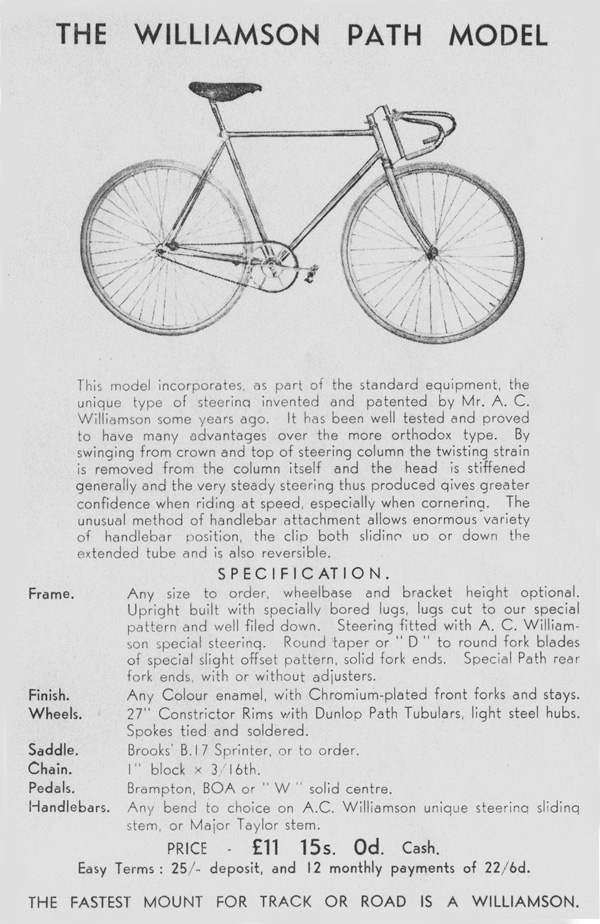Williamson Brothers
Posted: Tuesday 02nd June 2020
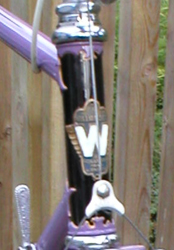
Evidence of Williamson Bros. from London street directories starts in 1926 under ‘Cycle Agents and Dealers’ and finishes in 1959 when the then owner, Wilf Allum, began to trade from a different address under his own name. Dating from about 1938, there are three addresses known, which is unusually ambitious for a ‘small’ maker. The main address throughout the period is 34, 36 and 38 (in various combinations), Holloway Road, London N7. It seems the business was started by the two Williamson brothers, who were keen clubmen, but by 1932, when George Smith was taken on to run the Willesden Lane shop, C.H. Bowles and his wife, their brother-in-law and sister, were in charge. Although the brothers had both left, or were in the process of leaving, in 1932, A.C. (Charlie) Williamson retained an interest until the time of a c1935 catalogue, whereas the c1938 catalogue states, ‘C.L. Bowles, Sole Proprietor’.
Machines inspected have been well-made, lightweight, racing, club and general purpose models with distinctive Williamson pattern lugs mentioned in the catalogue. Several innovations were also advertised (see below), so it is a mystery why Williamson never achieved the revered status of their neighbouring North London marques. Business must have been successful as the firm was able to mount a substantial stand at the 1935 Cycle Show. Cycling of November 27, 1935 states, “Twelve cycles and tandems, every one a lightweight, will comprise the exhibits on the stand of Williamson Bros . . . one that will, perhaps, attract the most attention is the Long-Distance model, a multi-geared machine of upright design, built on Continental lines”. Also from the pages of Cycling we find the firm exhibited at the Lightweight Show from 1932 to 1936. Paid advertising in Cycling has only been found in the classified section during the Thirties, where in 1938 they pushed their “Special upright frame, any wheelbase . . . £9.17.6 (£9.87) and their ‘Vertispee’ super upright model, 80 degrees head, 39″. wheelbase, weight 22lb. a real speediron, £10.15s (£10.75)”. These models can be found in the catalogue; the ‘Vertispee’ illustrating Bowles’ continual attempts to introducenew ideas even at the expense of practicability.
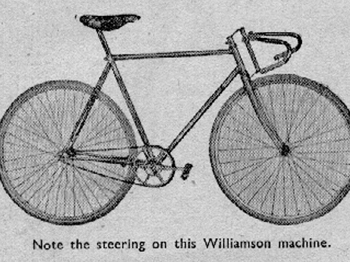
Other innovations include the special suspended steering for track use advertised in a show number of Cycling on 27 November 1935 (see image on right and catalogue at bottom of page)and a juvenile-back tandem of the same year. A.C Williamson is credited with the first somewhat dubious design and C.H. Bowles with the last. Undoubtedly Williamson’s most exciting and interesting idea is the ‘Trigide’ duplex frame for which an advertising leaflet exists as well as an actual example, which is slightly different and could be a prototype.
This had thin, Pedersen-like, frame tubes, brazed-up into a conventional shaped frame, with three down tubes arranged in elongated triangular form. The blurb states, ‘the design is based on the scientific fact that the triangle is the most rigid structure known and this principle . . . has been exploited to the full in designing this frame’. This innovation seems to have dated from just before or even during the war which may explain its rarity and short life.
Having worked under Bowles, by 1955 Wilf Allum was ‘proprietor’ which is stated on an existing invoice. The following year Cycling carried a small display ad for Williamson Bros stating ‘sole proprietor Wilf Allum’ and ‘Agent for Viking, Raleigh, Triumph, Urago, Dilecta and Higgins tricycles’.
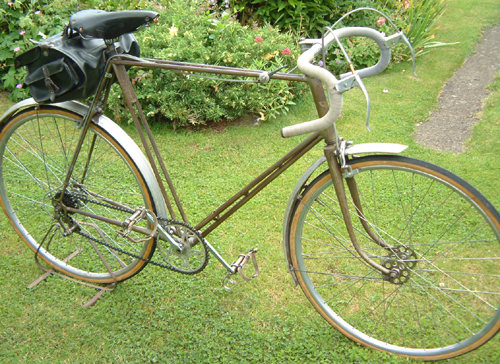
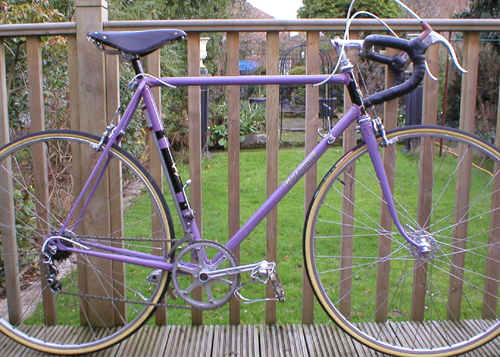
The question of who built Williamson’s machines remains, like so many lightweight makers, somewhat of a mystery. Allum has said that he thought Bowles was himself a competent builder, perhaps even from an engineering background, and it was he who taught Wilf to build frames. This is quite at variance with George Smith’s earlier impression which was that in 1932, when he joined the firm, no evidence of brazing equipment or a hearth was found. Also, in spite of Allum’s claim, one frame at least (that covered by the 1955 invoice above) seems to have been built by Jim Collier (ex-Gillott) as it has a distinctive rear brake bridge (See N&V 324/37 April/May 2008.) As an aside, after Collier left Gillott’s in the early ‘50s, he did work for both Williamson’s and Witcombe (as well as Youngs) which may explain why two frames purporting to be Williamson’s have turned-up with Witcomb head badges!
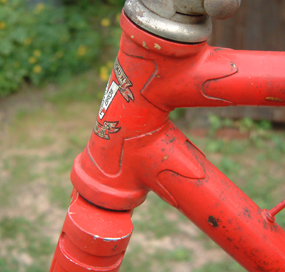
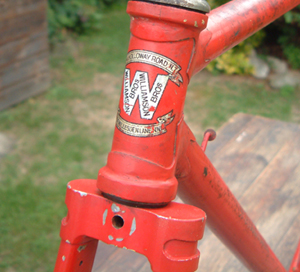
Wilf Allum had had a successful racing career with Viking Road Club, for whom he was Club Champion and Best All-rounder in 1952. He set-up under his own name as a ‘Cycle Maker’ at 114 Pitfield Street, N1, evidence for which can be found in the directories from 1960 until 1963.
I have not been able to make out a dating sequence from the frame numbers except in the case of the later, Allum supplied, machines. The 1955 invoice refers to frame number 5505. Most Williamson frame numbers can be found on the off-side rear end and also, on pre-war frames at least, behind the fork crown. All the pre-war numbers I know of except one begin with the figure ‘9’. The other bicycle number and the only trike number I have both begin.
Thanks to George Smith, and V-CC members George Bolton, Les Bowerman, Bryan Clarke, Chris Lovibond and Hilary Stone for their interest and help in trying to unravel this largely forgotten marque.
David Hibberd
Veteran-Cycle Club Marque Enthusiast
October 2008
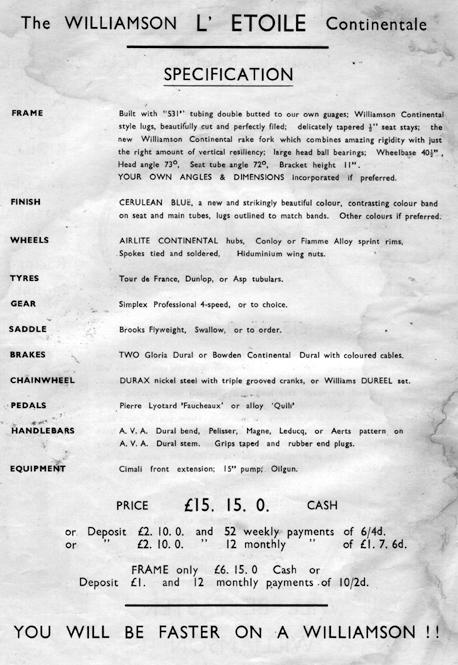
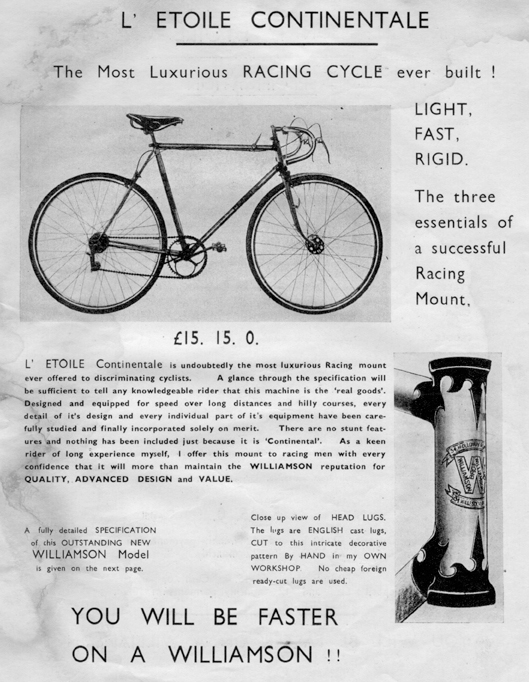
My dad grew up in Hartland Road which is close to Willesden Lane and his first job was working in an Ironmongers as a delivery boy aged 14. Their shop was practically next to the Williamson Brother’s premises. Williamson did all the repairs on their bicycles and he always coveted one of their superbly made lightweights. He never did achieve owning one and had to settle for a fifty-bob Hercules. This is the nearest he ever got, frequent visits to the shop, window gazing and this very old press cutting in his scrapbook.
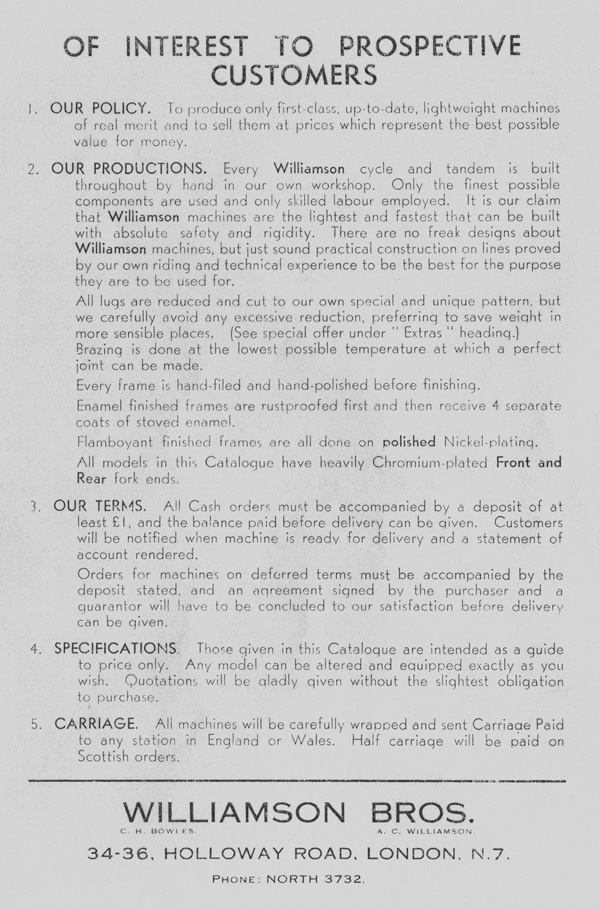
Cycling June 3rd 1936 “60 YEARS IN THE TRADE”
Mr. A. C. Williamson has retired after nearly 60 years in the bicycle trade. He was the founder of Wiliamson Brothers of 34-36 Holloway Road and Willesden Lane. His place in the firm has been taken by Mr. C. H. Bowles who has been connected to the firm for many years. He is a keen club rider and was for many years an honorary West London CTC official.
Wilf Allum Viking R.C., Jack Lauterwasser Finsbury Park, Cyril Wren Kingston R.C., George Chapman Polytechnic C.C. were all frame builders and cycling Freemason
Posted: Tuesday 02nd June 2020
This article appears in the following categories.
Upcoming Events
Whether you are looking for a gentle social meet up, or a 100-mile ride browse the community’s upcoming events and plan your next weekend outing.


